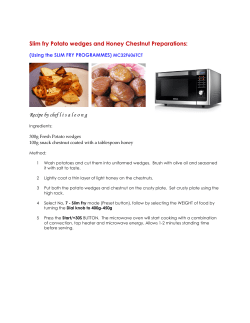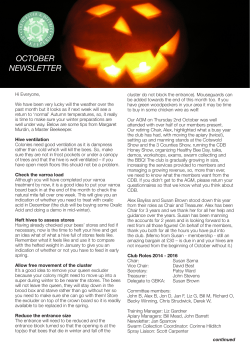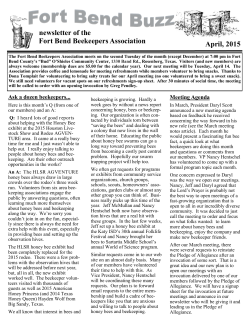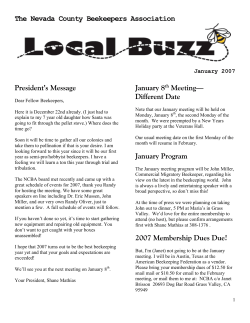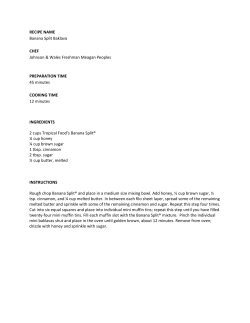
How to meet mānuka honey labelling requirements
How to meet mānuka honey labelling requirements This poster outlines the requirements of the New Zealand Food Act and Australia New Zealand Food Standards Code (the Code). There are additional requirements defined in the Fair Trading Act and Weights and Measures Regulations. General requirements A Name or description of the food Honey must be labelled as “honey” and alternative names cannot be used. See Standards 1.2.2 and 2.8.2 of the Code. B Floral source of the honey (optional) If you choose to include “Mānuka” on the label, you should ensure your honey meets the characteristics outlined in the Interim Labelling Guide for Mānuka Honey. C Name and address of the business A physical address of the manufacturer, packer or vendor is required. See Standard 1.2.2 of the Code. Bee’s Mānuka Honey 500g Flowers Food Ltd. 18 Main St, Wellington, New Zealand • You must ensure: –– Your label is in English and is easy to read. –– Any values (such as nutrition values and chemical compounds) are accurate. –– There are no misleading statements. –– Statements prohibited by the Code do not appear in advertisements, including websites. • There are no requirements as to where required information appears on the label. • If you are going to export your honey, you need to make sure you meet the requirements of the importing country. D Lot identification Lot identification is required. See Standard 1.2.2 of the Code. Lot:274ABC Important: Information contained in this document is only intended as a guide. For full information please see the Interim Labelling Guide for Mānuka Honey at: http://www.mpi.govt.nz/food/food-safety/manuka-honey 1 July 2014 How to meet mānuka honey labelling requirements Nutrition, Health and Related Claims • Nutrition content claims are permitted subject to conditions in Standard 1.2.7 of the Code. • Health claims are only possible if the following are met: a) Nutrient profiling scoring criterion is met. Note: Honey does not meet this criterion therefore a request for an exemption from this requirement* or re-categorisation* would need to be sought and approved; and b) It meets the conditions of an applicable pre-approved health claim set out in Standard 1.2.7; or c) *It meets the requirements of a self-substantiated health claim set out in Standard 1.2.7, Schedule 6. E Nutrition Information Requirements A nutrition information panel is required on the label and must follow the prescribed format. See Standard 1.2.8 of the Code. Therapeutic claims No therapeutic claims are allowed. See Standards 1.1A.2 and 1.2.7 of the Code. • Claims such as “Non-Peroxide Activity” (NPA), “Total Peroxide Activity”(TPA), “Peroxide Activity”(PA), “Total Activity” (TA) and “Active” should be removed from labels and advertising. Date marking Generally date marking is not applicable to honey as it is a product with a shelf life of over two years. NUTRITION INFORMATION *These are significant processes. Servings per package: 25 Serving size: 20 g Average Quantity per Serving Average Quantity per 100 g Energy 268 kJ 1340 kJ Protein 0.08 g 0.4 g 0g 0g 0g 15.9 g 15.6 g 2.4 mg 0g 79.6 g 78.1 g 12 mg Fat, total – saturated Carbohydrate – sugars Sodium Note: Standard 1.2.7 – Nutrition, Health and Related Claims was introduced on 18 January 2013 and regulates the use of nutrition content claims and health claims on food labels and in advertisements for food. During the 3 year transition process, which ends on 18 January 2016, food businesses can comply with either Standard 1.2.7 or Standard 1.1A.2 but not both. Other Statements (not therapeutic, health or nutrition content claims or other claims which have requirements defined in the Code) • The statement is truthful and accurate. • The statement can be substantiated. • Is not misleading or deceptive. The following are examples of possible statements if the above requirements are met: a) Product of New Zealand. b) Presence of a chemical marker e.g. 250mg/kg methylglyoxal. c) Grading systems such as 5+ etc, if grading parameters are meaningful, able to be verified, declared and explained on the label, are not therapeutic or health claims and do not contravene labelling legislation. If you choose to include a date mark, use “Best Before”. The date must consist of at least the month and year, expressed in that order e.g. “Best Before Dec 2015” or “Best Before 12 2015”. See Standard 1.2.5 of the Code. 2 July 2014
© Copyright 2025








